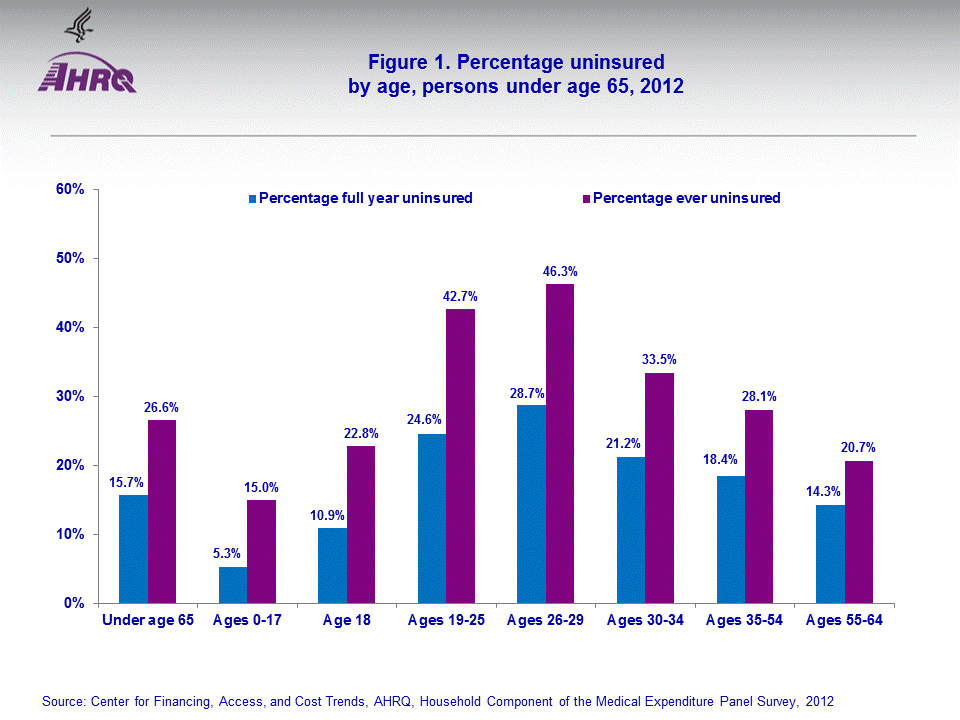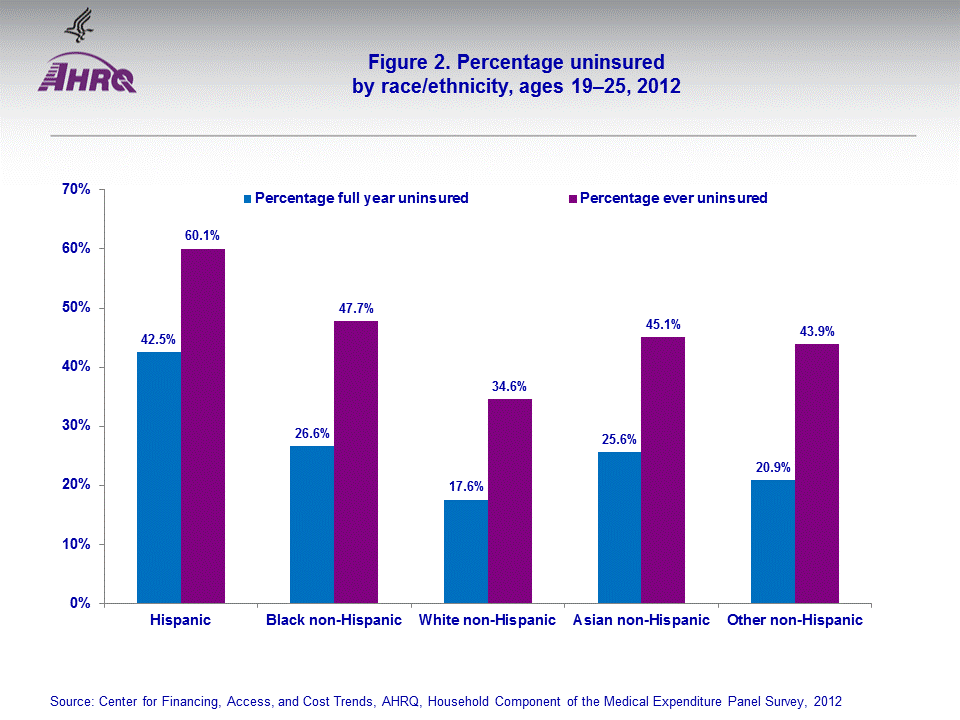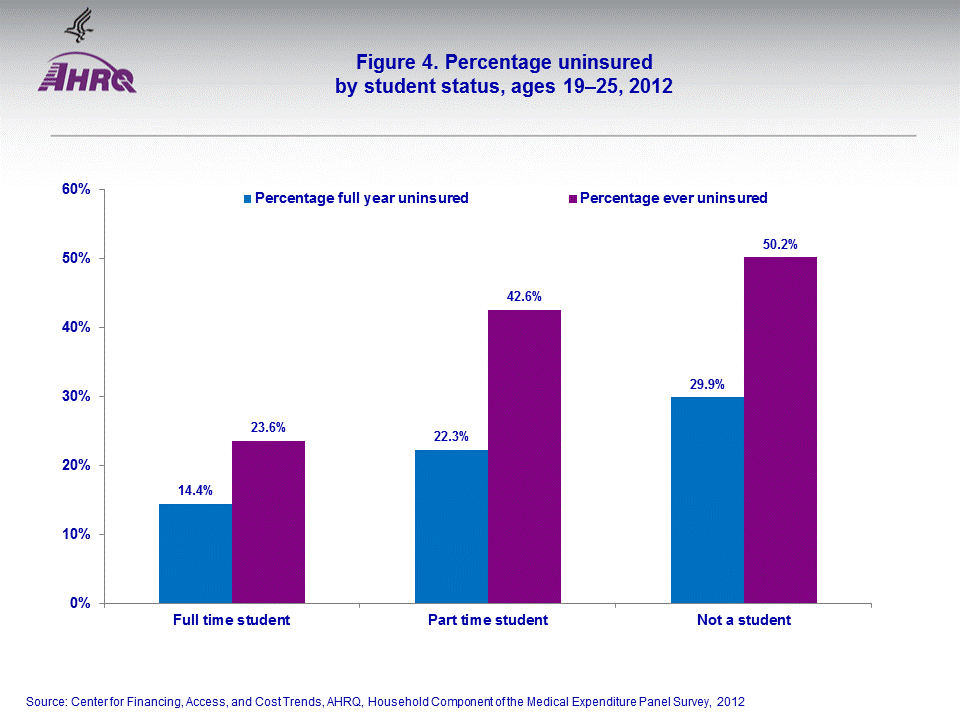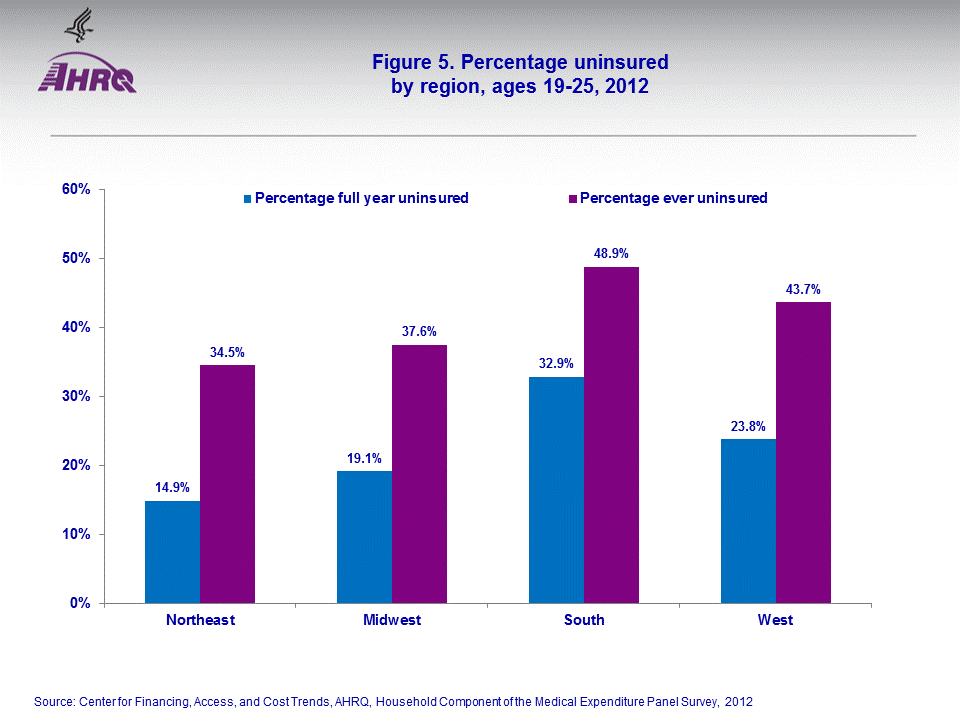
|
|
Font Size:
|
||||
|
|
|
|
||||
STATISTICAL BRIEF #437:
Health Insurance Status of Young Adults Ages 19-25, 2012
Highlights
- Among young adults ages 19-25, 42.7 percent were uninsured at some point in 2012 and 24.6 percent were uninsured for the entire year. For this same population, 47.9 percent were uninsured at some point in 2009 and 27.5 percent were uninsured for the entire year (2009 estimates not shown).
- For young adults ages 19-25, Hispanics were substantially more likely than black non-Hispanics, white non-Hispanics, Asian non-Hispanics, or other non-Hispanics to lack health insurance during 2012.
- Young adult males were more likely than their female counterparts to lack health insurance for all of 2012.
- Full time students were the least likely to be uninsured for the entire year or any part of the year in 2012.
- Young adults living in the South were the most likely to be uninsured for all of 2012.
Introduction
Estimates of the health insurance status of the U.S. civilian noninstitutionalized population are critical to policymakers and others concerned with access to medical care and the cost and quality of that care. Health insurance helps people get timely access to medical care and protects them against the risk of expensive and unanticipated medical events. Young adults are less likely to be covered by health insurance than their older counterparts.Using information from the Household Component of the Medical Expenditure Panel Survey (MEPS-HC), this Statistical Brief provides estimates of uninsured rates for the U.S. civilian noninstitutionalized population between ages 19–25. Variations in uninsured rates for both anytime during the year and the entire year are examined by race/ethnicity, sex, student status, and region. All differences between estimates discussed in the text are statistically significant at the 0.05 level unless otherwise noted.
Findings
According to the MEPS-HC, 26.6 percent (71.4 million people, estimate not shown) of the population under age 65 were uninsured at some time in 2012 and 15.7 percent (42.1 million people, estimate not shown) were uninsured for the entire calendar year. When examining the coverage experience by age subgroups, 42.7 percent (13.6 million people, estimate not shown) of young adults ages 19–25 were uninsured at some point in 2012 and 24.6 percent (7.9 million people, estimate not shown) were uninsured for the entire calendar year (figure 1). For this same population, young adults ages 19–25, 47.9 percent were uninsured at some point in 2009 and 27.5 percent were uninsured for the entire calendar year (estimates not shown).For young adults ages 19–25, Hispanics were substantially more likely than black non-Hispanics, white non-Hispanics, Asian non-Hispanics, or other non-Hispanics to lack health insurance during 2012. Among Hispanic young adults, 60.1 percent were uninsured for at least part of 2012 while 42.5 percent were uninsured for the entire year. In contrast, 34.6 percent of white non-Hispanics between the ages of 19–25 were uninsured for at least part of the year while 17.6 percent were uninsured for the entire year (figure 2).
Among young adults, the percentage uninsured for the entire year or any part of the year varied by student status. Full time students were the least likely to be uninsured for the entire year (14.4 percent) or any part of the year (23.6 percent) in 2012. This compares to part time students (22.3 percent and 42.6 percent, respectively) and those who were not students (29.9 percent and 50.2 percent, respectively) (figure 4).
Health insurance status varied by region for young adults. Young adults living in the South were the most likely to be uninsured for all of 2012 (32.9 percent). In contrast, the percentages of those ages 19–25 in the Northeast, Midwest, and West who were uninsured for the entire year were 14.9 percent, 19.1 percent, and 23.8 percent, respectively (figure 5).
Data Source
The estimates shown in this Statistical Brief are drawn from analyses conducted by the MEPS staff from the following public use file: HC-149: 2012 Full Year Population Characteristics.Definitions
UninsuredPeople who did not have health insurance coverage at any time during the survey year were classified as uninsured for the full year. People who lacked coverage for at least one month during the year were classified as ever uninsured during the year. People who were covered only by noncomprehensive State-specific programs (e.g., Maryland Kidney Disease Program) or private single-service plans (e.g., coverage for dental or vision care only, coverage for accidents or specific diseases) were considered to be uninsured.
Region
Each MEPS sampled person was classified as living in one the following four regions as defined by the U.S. Census Bureau:
- Northeast: Maine, New Hampshire, Vermont, Massachusetts, Rhode Island, Connecticut, New York, New Jersey, and Pennsylvania.
- Midwest: Ohio, Indiana, Illinois, Michigan, Wisconsin, Minnesota, Iowa, Missouri, South Dakota, North Dakota, Nebraska, and Kansas.
- South: Delaware, Maryland, District of Columbia, Virginia, West Virginia, North Carolina, South Carolina, Georgia, Florida, Kentucky, Tennessee, Alabama, Mississippi, Arkansas, Louisiana, Oklahoma, and Texas.
- West: Montana, Idaho, Wyoming, Colorado, New Mexico, Arizona, Utah, Nevada, Washington, Oregon, California, Alaska, and Hawaii.
About MEPS-HC
MEPS-HC is a nationally representative longitudinal survey that collects detailed information on health care utilization and expenditures, health insurance, and health status, as well as a wide variety of social, demographic, and economic characteristics for the U.S. civilian noninstitutionalized population. It is co-sponsored by the Agency for Healthcare Research and Quality and the National Center for Health Statistics. For more information about MEPS, call the MEPS information coordinator at AHRQ (301-427-1656) or visit the MEPS Web site at http://www.meps.ahrq.gov/.References
For a detailed description of the MEPS-HC survey design, sample design, and methods used to minimize sources of nonsampling error, see the following publications:Cohen, J. Design and Methods of the Medical Expenditure Panel Survey Household Component. MEPS Methodology Report No. 1. AHCPR Pub. No. 97-0026. Rockville, MD: Agency for Healthcare Policy and Research, 1997. http://meps.ahrq.gov/mepsweb/data_files/publications/mr1/mr1.shtml
Cohen, S. Sample Design of the 1996 Medical Expenditure Panel Survey Household Component. MEPS Methodology Report No. 2. AHCPR Pub. No. 97-0027. Rockville, MD: Agency for Health Care Policy and Research, 1997. http://meps.ahrq.gov/mepsweb/data_files/publications/mr2/mr2.shtml
Cohen, S. Design Strategies and Innovations in the Medical Expenditure Panel Survey. Medical Care, July 2003: 41(7) Supplement: III-5–III-12.
Ezzati-Rice, T.M., Rohde, F., Greenblatt, J. Sample Design of the Medical Expenditure Panel Survey Household Component, 1998–2007. Methodology Report No. 22. March 2008. Agency for Healthcare Research and Quality, Rockville, MD. http://www.meps.ahrq.gov/mepsweb/data_files/publications/mr22/mr22.shtml
Suggested Citation
Rhoades, J.A. Health Insurance Status of Young Adults Ages 19–25, 2012. Statistical Brief #437. May 2014. Agency for Healthcare Research and Quality, Rockville, MD. http://www.meps.ahrq.gov/mepsweb/data_files/publications/st437/stat437.pdfAHRQ welcomes questions and comments from readers of this publication who are interested in obtaining more information about access, cost, use, financing, and quality of health care in the United States. We also invite you to tell us how you are using this Statistical Brief and other MEPS data and tools and to share suggestions on how MEPS products might be enhanced to further meet your needs. Please email us at MEPSProjectDirector@ahrq.hhs.gov or send a letter to the address below:
Steven B. Cohen, PhD, Director
Center for Financing, Access, and Cost Trends
Agency for Healthcare Research and Quality
540 Gaither Road
Rockville, MD 20850
 |
||||||||||||||||||||||||||||||
|
||||||||||||||||||||||||||||||
|
|
||||||||||||||||||||||||||||||
 |
||||||||||||||||||||||||||||||
|
||||||||||||||||||||||||||||||
|
|
||||||||||||||||||||||||||||||
 |
||||||||||||||||||||||||||||||
|
||||||||||||||||||||||||||||||
|
|
||||||||||||||||||||||||||||||
 |
||||||||||||||||||||||||||||||
|
||||||||||||||||||||||||||||||
|
|
||||||||||||||||||||||||||||||
 |
||||||||||||||||||||||||||||||
|
||||||||||||||||||||||||||||||
|
|
||||||||||||||||||||||||||||||


